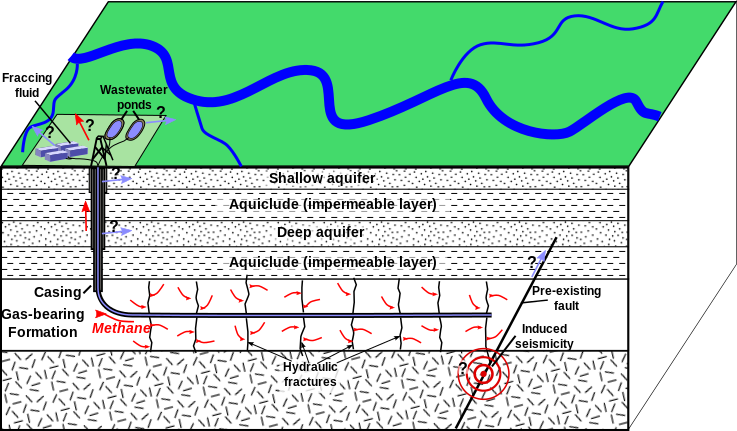Radioactivity from Fracking
The relationship between fracking and nuclear power is complex. The most obvious connection is the fact that inexpensive natural gas being produced by the current fracking boom in the United States is making nuclear power unprofitable and has already contributed to the decision to close two nuclear reactors in the United States. However, it turns out that there is another important link that is not so widely publicized.
Fracking is a process where they drill a hole in the ground between one thousand and eight thousand feet deep. Then the drill turns and drives horizontally through a rock strata that contains trapped natural gas and oil. Shaped explosive charges are used to shatter or fracture the rock around the drill pipe which is perforated along its horizontal length.
Following the drilling and fracturing, a mixture of water, acids, and chemical additives is forced under great pressure into the fracture rock strata. The initial injection is followed by small balls or sand that holds open the cracks in the rock. Natural gas, oil and the water mixture is pumped back to the surface. The exact type and quantities of the chemicals added to the water are proprietary but what is known is that many of them are toxic.
Fracking companies claim that it is a safe process where the nasty chemicals are below and separated from the water table that people draw on for water but critics point to evidence that fracking chemicals are making their way into the drinking water of people in the area and causing serious health problems. In addition there is evidence that fracking can cause earthquakes in the vicinity. Recently, in the Southwest, some towns are dying as fracking companies draw down the aquifers so much for the water they need to inject into the earth that wells that supply the towns with water are drying up.
In addition to the oil and natural gas trapped underground the rock strata, there is also naturally occurring uranium. Most of it is the mildly radioactive isotope U-238. But there are also other more radioactive isotopes created from the decay of the U-238 such as radium 226. Radium 226 decays into radon-222, a radioactive colorless and odorless gas that emits alpha particles. Radon also decays and, among its products is highly toxic polonium 210. These naturally occurring radioactive isotopes are normally deep underground and no threat to human beings. However, in the vicinity of fracking operations, these isotopes are being brought to the surface and are a definite biological threat. They are in the waste water, the oil, the gas, the soil, the groundwater and they can make their way into municipal wells, water supplies, and people homes.
Originally, the shaped charges created a jet of super heated copper that blasted through the rock. But since the 1980, new types of charges have been developed that use depleted uranium that are claimed to be five times as effective as the old copper charges. The temperature of the jet of uranium is twice the temperature of the copper jets. This super heated uranium engages in chemical reaction and the creation of new compounds with the chemicals naturally present in the rock. It is likely that the particles of depleted uranium created by the explosion of the charges make their way back to the surface mixed with the gas, oil and water. They could be carried by spilled waste water into the soil, streams, rivers and groundwater around the fracking site. It would be difficult to identify such depleted uranium radioactivity from the natural radioactivity of radium and radon.
Both the natural radioactivity from fracking and the radioactivity from the charges pose a threat to the public health. Such radioactive contamination in the area of fracking sites could lead to tens of thousands of additional cases of lung cancer. This is a serious issue which should be addressed when the safety and economics of fracking are being discussed.
